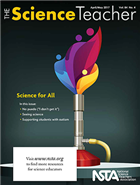Commentary: Going Beyond the Textbook
By sstuckey
Posted on 2017-04-27

It has been said that science began “whenever and wherever [people] tried to solve the innumerable problems of life” (Sarton 1952). The Next Generation Science Standards (NGSS Lead States 2013) call for the pursuit of scientific literacy for all through science instruction. This includes acknowledging the contributions to science of those whose communities have been historically marginalized.
The contributions of non-Europeans
Unfortunately, science educators often fail to acknowledge the contributions of non-Europeans. We also fail to convey the complex, messy, culturally contextualized aspects of scientific progress not found in most textbooks.
Consider, for example, the story of the smallpox vaccination. English scientist Edward Jenner has been credited with developing a cure for the deadly disease, a cure that ultimately lead to the acceptance of immunology in the 1800s (Johnson and Raven 2006). However, records indicate that long before Jenner was born, Africans practiced a form of inoculation by scratching the arm of a healthy individual with a tool infected with the offending virus, eventually protecting the person from the illness.
During a smallpox outbreak in the American colonies in the early 1700s, a slave named Onesimus explained the African practice to a puritan  minister, Cotton Mather, who in turn persuaded a local doctor, Zabdiel Boylston, to use it (Herbert 1975). Their willingness to accept African knowledge saved lives during the outbreak. Unfortunately, few textbooks addressing the origins of vaccinations mention the African practice or the story of Onesimus.
minister, Cotton Mather, who in turn persuaded a local doctor, Zabdiel Boylston, to use it (Herbert 1975). Their willingness to accept African knowledge saved lives during the outbreak. Unfortunately, few textbooks addressing the origins of vaccinations mention the African practice or the story of Onesimus.
Although there is little empirical evidence to support the seemingly intuitive practice of incorporating the history of science to improve students’ understanding of the nature of science (Abd-El-Khalick and Lederman 2000), many science educators acknowledge the potential of such instruction to augment student understanding of science.
Finding fresh resources
If teachers are to engage their diverse students in more meaningful discussions about the history and nature of science, we have to go beyond the sterile stories propagated by textbooks and research other resources to support our efforts. Good choices include the books Acid Tongues and Tranquil Dreamers (White 2001), A Short History of Nearly Everything (Bryson 2003), Blacks and Science, Volume Three (Walker 2013), and Hidden Figures (Shetterly 2016), the book on which the Academy Award–nominated film was based.
Students need to see connections between science learning and their experiences and cultures (Gay 2002; Ladson-Billings 1992). Becoming more inclusive in our representations of science in the classroom is important to developing an understanding of who does science, how science is done, and how science progresses. This will benefit students, teachers, and society.
Karen Rose (kr04@fsu.edu) is a clinical science education instructor in the FSU-Teach program at Florida State University in Tallahassee, Florida.
References
Abd-El-Khalick, F., and N.G. Lederman. 2000. The influence of history of science courses on students’ views of nature of science. Journal of Research in Science Teaching 37 (10): 1057–1095.
Bryson, B. 2003. A short history of nearly everything. New York: Broadway Books.
Gay, G. 2002. Preparing for culturally responsive teaching. Journal of Teacher Education 53 (2): 106–116.
Herbert, E. 1975. Smallpox inoculation in Africa. Journal of African History 16 (4): 539–559.
Johnson, G., and P. Raven. 2006. Biology. Austin, TX: Holt, Rinehart, and Winston.
Ladson-Billings, G. 1992. Culturally relevant teaching: The key to making multicultural education work. In Research and multicultural education: From the margins to the mainstream, ed. C. Grant, 102–118. Bristol, PA: The Falmer Press.
NGSS Lead States. 2013. Next Generation Science Standards: For states, by states. Washington, DC: National Academies Press.
Sarton, G. 1952. A history of science: Ancient science through the golden age of Greece. Cambridge, MA: Harvard Press.
Shetterly, M. 2016. Hidden Figures. New York: HarperCollins.
Walker, R. 2013. Blacks and science, volume three: African-American contributions to science and technology. London: Recklaw Education.
White, M. 2001. Acid tongues and tranquil dreamers: Tales of bitter rivalries that fueled the advancement of sciences and technology. New York: HarperCollins.
Editor’s Note
This article was originally published in the April/May 2017 issue of The
Science Teacher journal from the National Science Teachers Association (NSTA).
Get Involved With NSTA!
Join NSTA today and receive The Science Teacher,
the peer-reviewed journal just for high school teachers; to write for the journal, see our Author Guidelines, Call for Papers, and annotated sample manuscript; connect on the high school level science teaching list (members can sign up on the list server); or consider joining your peers at future NSTA conferences.
Disclaimer: The views expressed in this blog post are those of the author(s) and do not necessarily reflect the official position of the National Science Teaching Association (NSTA).


